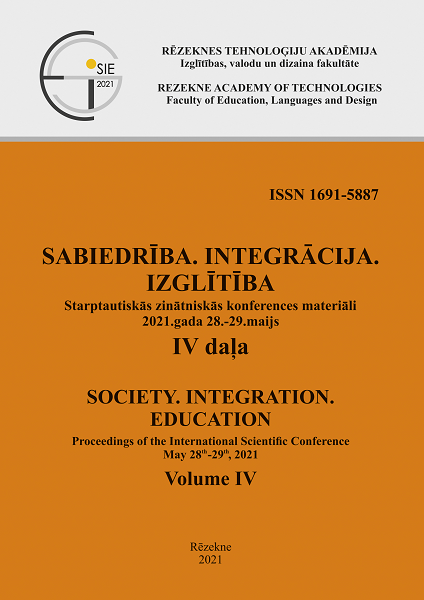WHY SERVICE DESIGN MATTERS: THE CASE OF NATIONAL LIBRARY OF LATVIA
DOI:
https://doi.org/10.17770/sie2021vol4.6267Keywords:
The publication was prepared with the support from the National research programme project (No. PP-IZM-2018/1-0022) The Significance of Documentary Heritage in Creating Synergies between Research and Society”.Abstract
In the digital age when many organizations initiate and experience transformations as a reaction to wider societal changes, there is discussion about functionality, usability and availability of library services. Studies report a decreasing number of library visitors as result of the pervasive presence of the Internet as a faster source for getting resources, public`s lack of knowledge about the library services, etc. To maintain relevance for the public, more libraries apply principles of service design to provide an effective customer experience. For national libraries websites are of high importance as gateways to library resources and media to communicate institutions` objectives. The aim of this article is to analyse how the principles of service design are reflected in the online services offered by the National Library of Latvia. The research methods rely both on secondary data on audience needs and involve application of the service design principles to the website of National Library of Latvia. Results highlight the majority of analysed libraries apply the basic principles of service design and the focus is to provide the user friendly experience in libraries` databases and repositories. The website of the library provides limited user friendly experience in library`s and only partially follows the principles of service design.
References
Brindley, L. (2008). The International Dimensions of Digital Science and Scholarship: Aspirations of the British Library in Serving the International Scientific and Scholarly Communities. In R.Earnshaw & J.Vince (Eds.), Digital convergence – libraries of the future (65-74). London: Springer.
Chen,S., Coughlan, J., Love,S., Macredie, R.D. & Wilson,F. (2008). Cognitive Implications of Information Spaces: Human Issues in the Design and Use of Electronic Library Interfaces. In R.Earnshaw & J.Vince (Eds.), Digital convergence – libraries of the future (253-272). London: Springer.
Chowdhury, G., Poulter, A. & D.McMenemy (2006). Public Library 2.0: Towards a new mission for public libraries as a "network of community knowledge", Online Information Review. Retrieved from https://pdfs.semanticscholar.org/3958/066da6a07e53a9efce975ff2d80b63370431.pdf?_ga=2.56935786.1164214329.1611843229-627222017.1607692467
Department for Culture, Media and Sport (2015 - 2016). Statistical release. Taking Part 2016/17 Quarter 2. England. Retrieved from https://assets.publishing.service.gov.uk/government/uploads/system/uploads/attachment_data/file/586932/Taking_Part_2016-17_Q2_Report.pdf
Duke, L.M.& Asher, A.D. (2012). Conclusions and Future research. In Duke, L.M., Asher, A.D. (Eds.) College Libraries and Student Culture: What We Now Know. ALA Editions, Chicago, U.S.
EBLIDA (2013-2015). Public libraries statistics 2013-2015. Retrieved from: http://www.eblida.org/activities/kic/public-libraries-statistics.html
European Parliament (2016). Directorate-General for internal policies. Research for Cult Committee: Public libraries - their new role. Retrieved from: https://www.europarl.europa.eu/RegData/etudes/STUD/2016/585882/IPOL_STU(2016)585882_EN.pdf
Fernández-Ardèvol, M., Ferran-Ferrer, N., Nieto-Arroyo, J. & Fenoll, C. (2018). The public library as seen by the non-users. El profesional de la información, 27(3), 659-670. Retrieved from http://www.elprofesionaldelainformacion.com/contenidos/2018/may/19.pdf
Gibbons, S. (2013). Techniques to understand the changing needs of library users. IFLA Journal, 39 (2), 162-167.
Gordon, I.D., Meindl, P., White, M. & Szigeti, K. (2018). Information Seeking Behaviors, Attitudes, and Choices of Academic Chemists, Science & Technology Libraries, 37(2), 130-151. DOI: 10.1080/0194262X.2018.1445063
Grönroos, C. & Voima, P. (2013). Critical Service Logic: Making Sense of Value Creation and Co-Creation. Journal of the Academy of Marketing Science, 41 (2), 133–150.
Harbo, K. & T.V.Hansen (2012). Getting to Know Library Users’ Needs — Experimental Ways to User-centred Library Innovation. LIBER Quarterly, 21(3-4):367-385.
Katzan, H. Jr. (2011). Essentials of Service Design. Journal of Service Science 4(2), 43 - 60.
Kous, K., Pušnik, M., Hericko & M., Polancic, G. (2018). Usability evaluation of a library website with different end user groups. Journal of Librarianship and Information Science. 52(3), 75-90,
Latvijas Nacionālā bibliotēka (2019). Latvijas Nacionālās bibliotēkas attīstības stratēģija 2019.-2023.gadam. [Strategy of National Library of Latvia 2019-2023]. Retrieved from https://www.lnb.lv/sites/default/files/media/par-lnb/institucija/LNB_strategija_LV.pdf
Latvijas Nacionālā bibliotēka (2020). Latvijas Nacionālās bibliotēkas darbības publiskais pārskats. 2019.gads. Retrieved from https://www.lnb.lv/sites/default/files/media/par-lnb/institucija/lnb-darbibas-publiskais-parskats-2019.pdf
Lippincott, J.K. (2005). Net Generation Students and Libraries. Coalition for Networked Information. Retrieved from https://www.educause.edu/research-and-publications/books/educating-net-generation/net-generation-students-and-libraries
Martins, A.B., Cortes, C.& Gabriel, G. (2001). Communication in the Library: The Role of Librarians. FESABID 2011 conference. DOI: 10.13140/RG.2.1.3731.2407
Marquez, J.& Downey, A. (2015). Service Design: An Introduction to a Holistic Assessment Methodology of Library Services. Journal of Library User Experience Vol. 1 (2).
El Mimouni, Anderson, Tempelman-Kluit, & Dolan-Mescal, (2018). UX Work in Libraries: How (and Why) to Do It. L.Costello & M.Powers (Eds.). Developing In-House Digital Tools in Library Spaces. IGI Global.
Morelli, N., De Götzen, A. & Simeone, L. (2021). What do we mean by service design capabilities? In Morelli, N., De Götzen, A., Simeone, L. (Eds.), Service Design Capabilities.
Nyame, P., Lu, Z. & Fu, Q. (2019). Developing Usable Academic Library Website for International Students through Usability Testing. Open Access Library Journal, 6 (04), 1-22.
Park-Lee, S. (2020) Contexts of briefing for service design procurements in the Finnish public sector. Design Studies 69, 1-39. DOI: 10.1016/j.destud.2020.05.002
Perrin, J.M., Clark, M., Medina de Leon, E. & Edgar, L. (2014). Usability Testing for Greater Impact: A Primo Case Study. Information Technology and Libraries, 33(4). DOI:10.6017/ital.v33i4.5174
Radford, M. & L.S.Connaway, (2015). ‘Screenagers’ and Live Chat Reference: Living Up to the Promise. In L.S.Connaway (Ed.),The Library in the Life of the User Engaging with People Where They Live and Learn (53-65). Dublin: OCLC Online Computer Library Center. Retrieved from https://files.eric.ed.gov/fulltext/ED570948.pdf
Sørensen, K.M. (2020). Where’s the value? The worth of public libraries: A systematic review of findings, methods and research gaps. Library and Information Science Research. DOI: https://doi.org/10.1016/j.lisr.2020.101067
The Royal Society (2012). Science as an open enterprise. Retrieved from https://royalsociety.org/-/media/policy/projects/sape/2012-06-20-saoe.pdf
Thoelen, A.& Cleeren, S. (Eds.). (2015). Public Service Design A guide for the application of service design in public organisations. Brussels: Design Flanders. Retrieved from https://www.servicedesignmaster.com/wordpress/wp-content/uploads/2016/10/Public-Service-Design.-A-guide-for-the-application-of-service-design-in-public-organizations..pdf
Vargo, S.L., Lush, R. (2008) Service-Dominant Logic” Continuing the Evolution. Journal of the Academy of Marketing Science, 36 (1), 1-10.
Verma, R., Gustafsson, A., Kristensson, P. & Witell, L. (2012). Customer Co-Creation in Service Innovation: A Matter of Communication? Journal of Service Management, 23 (3), 311–327.






